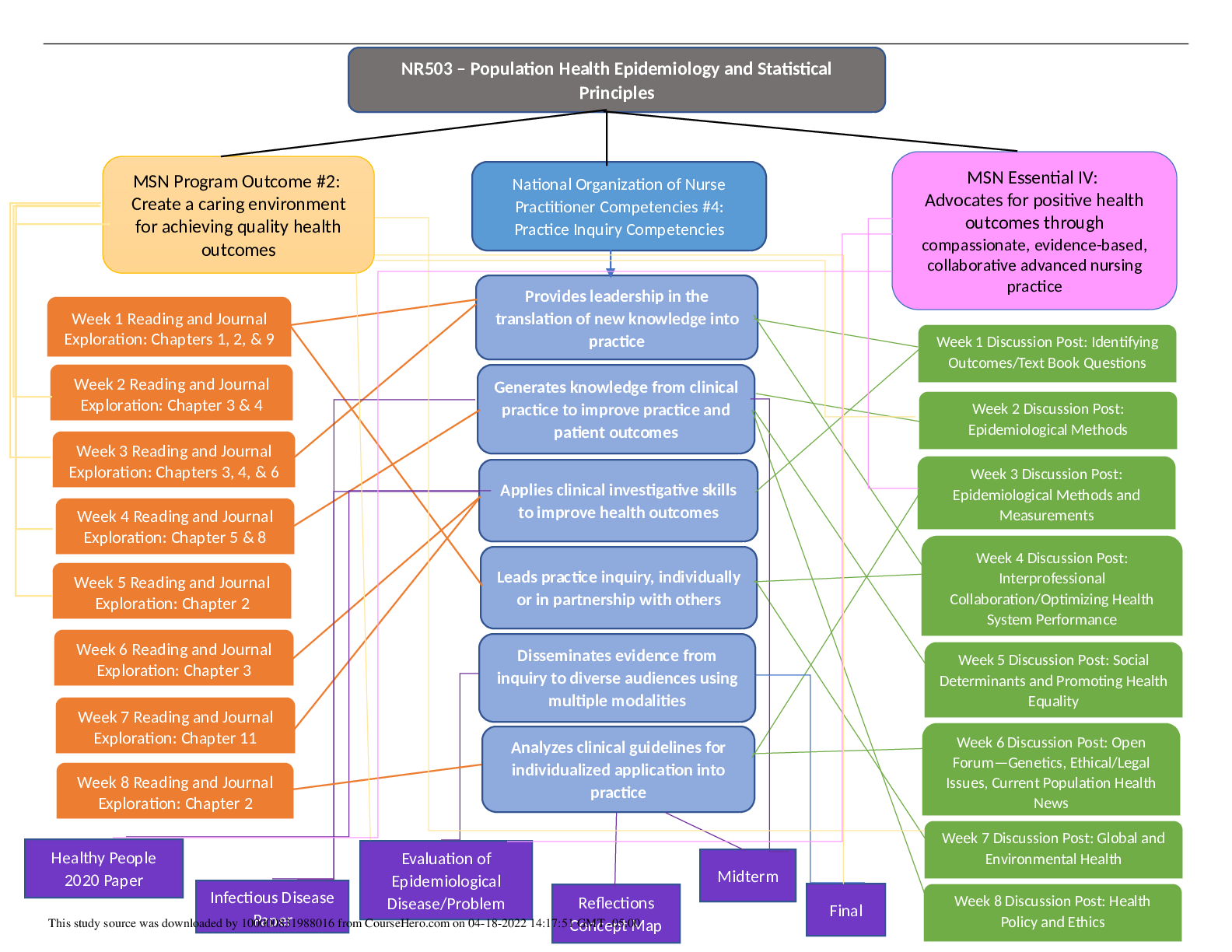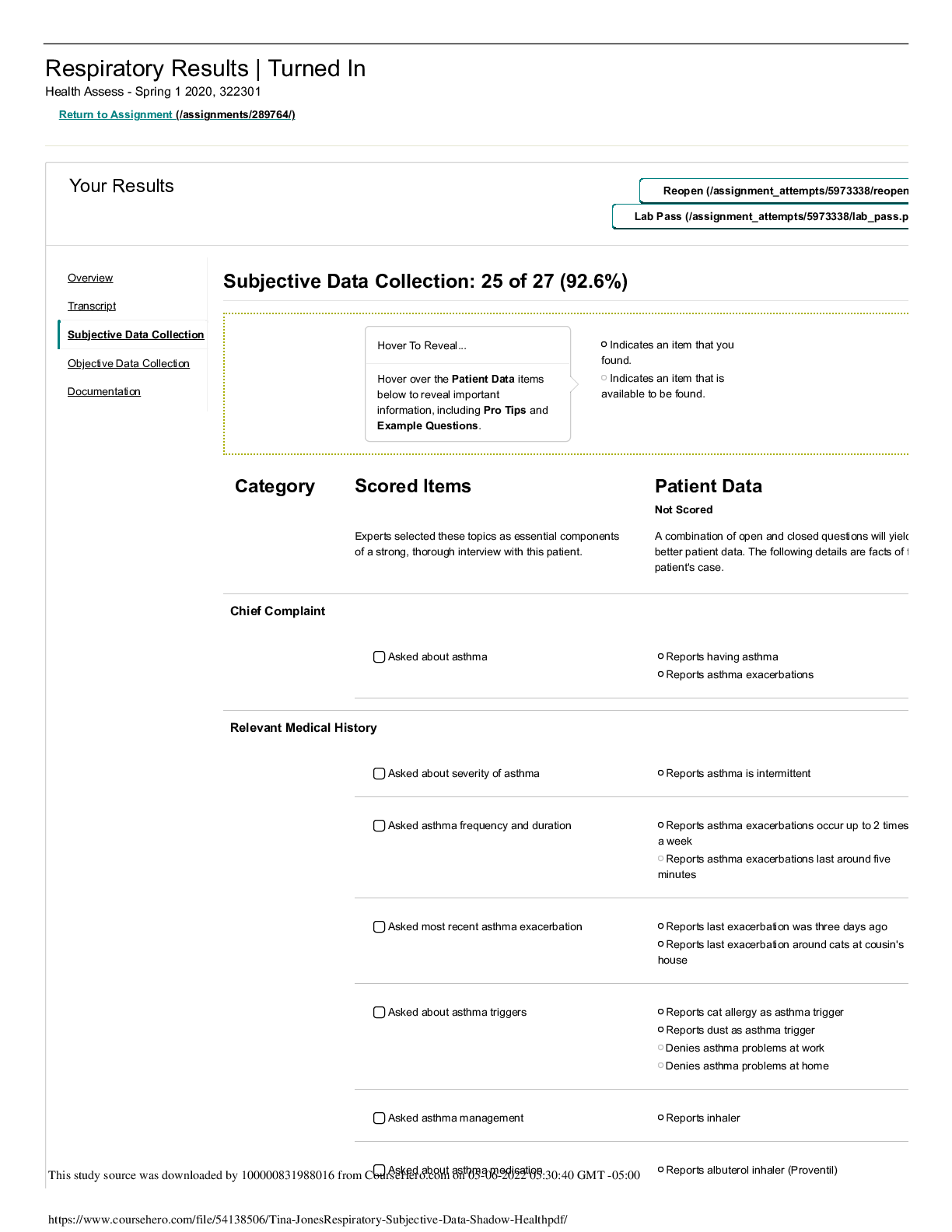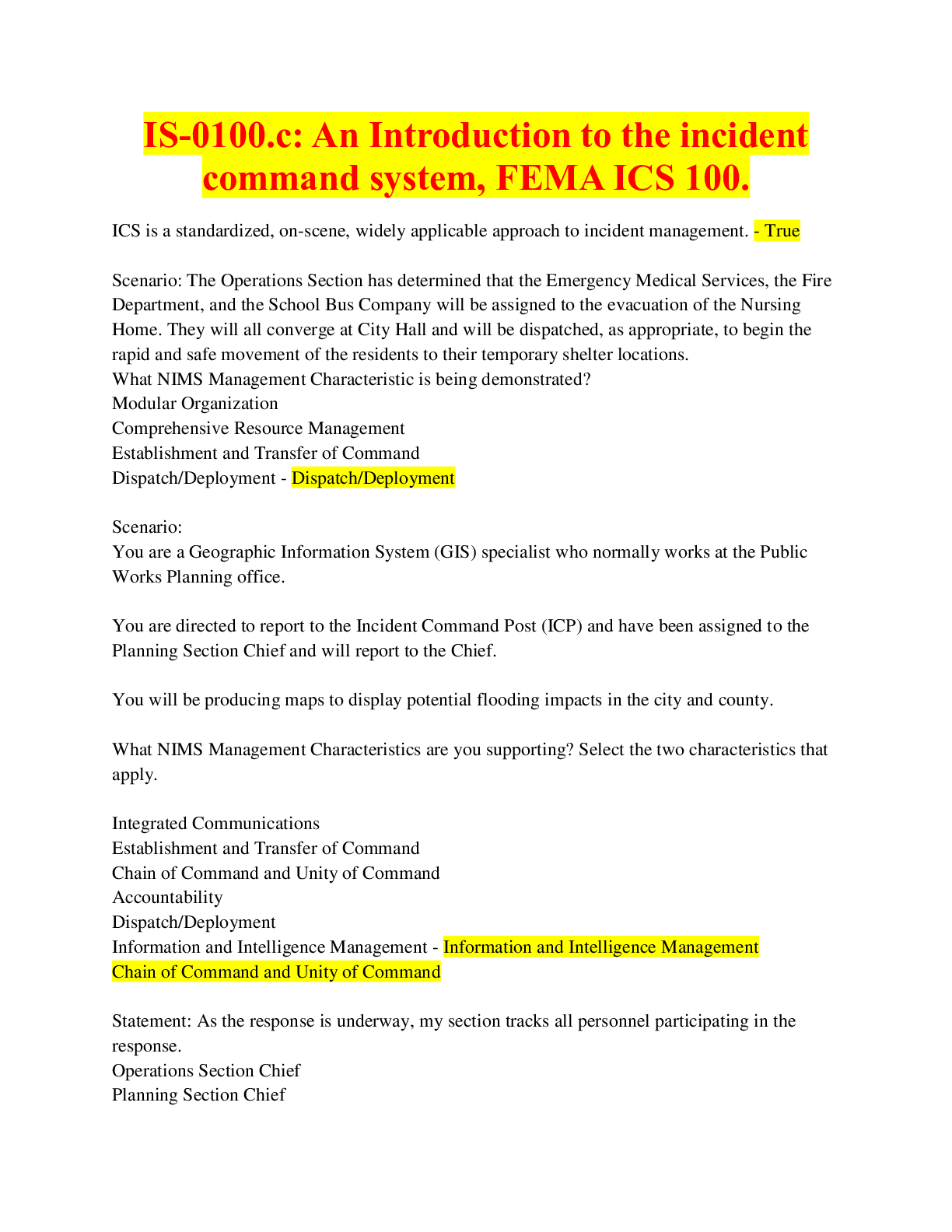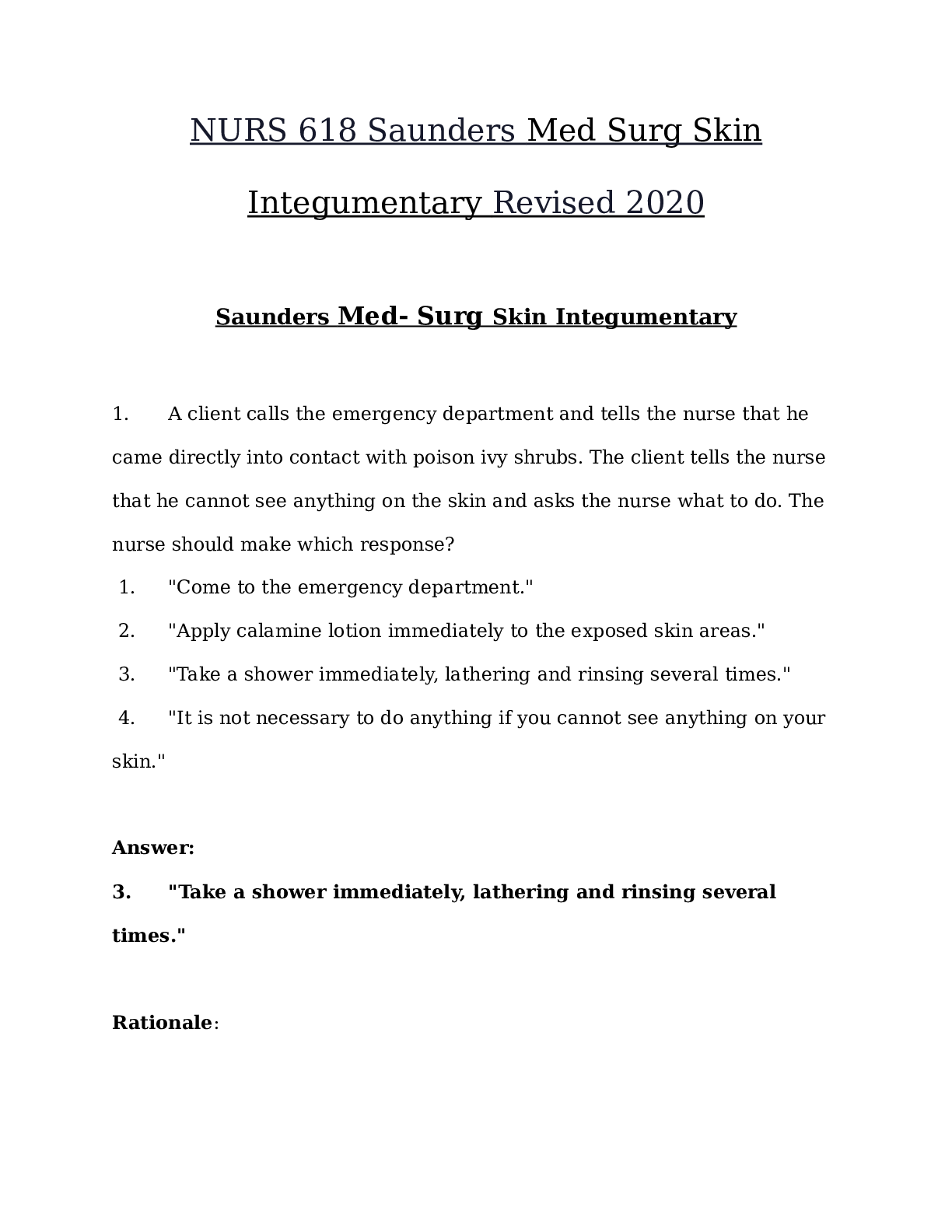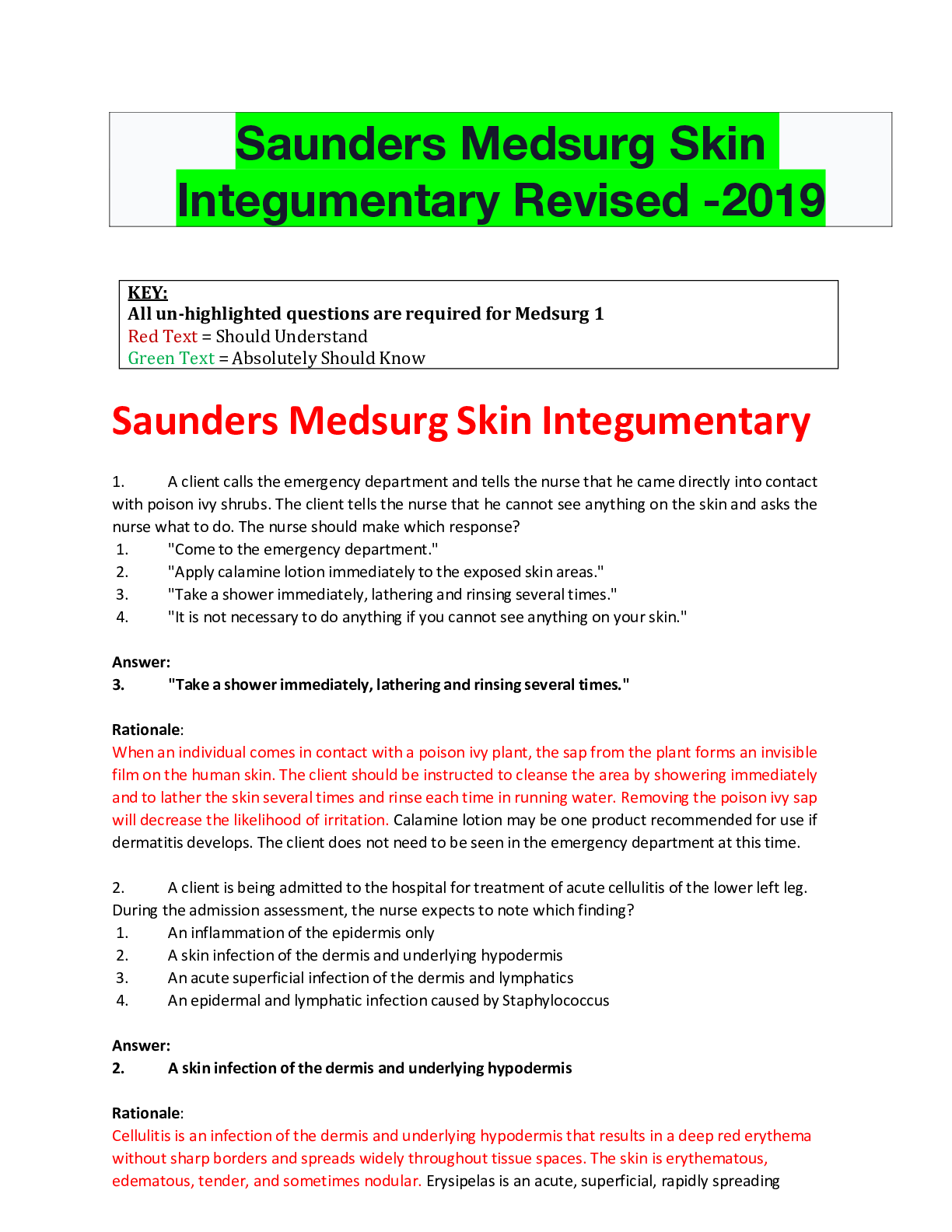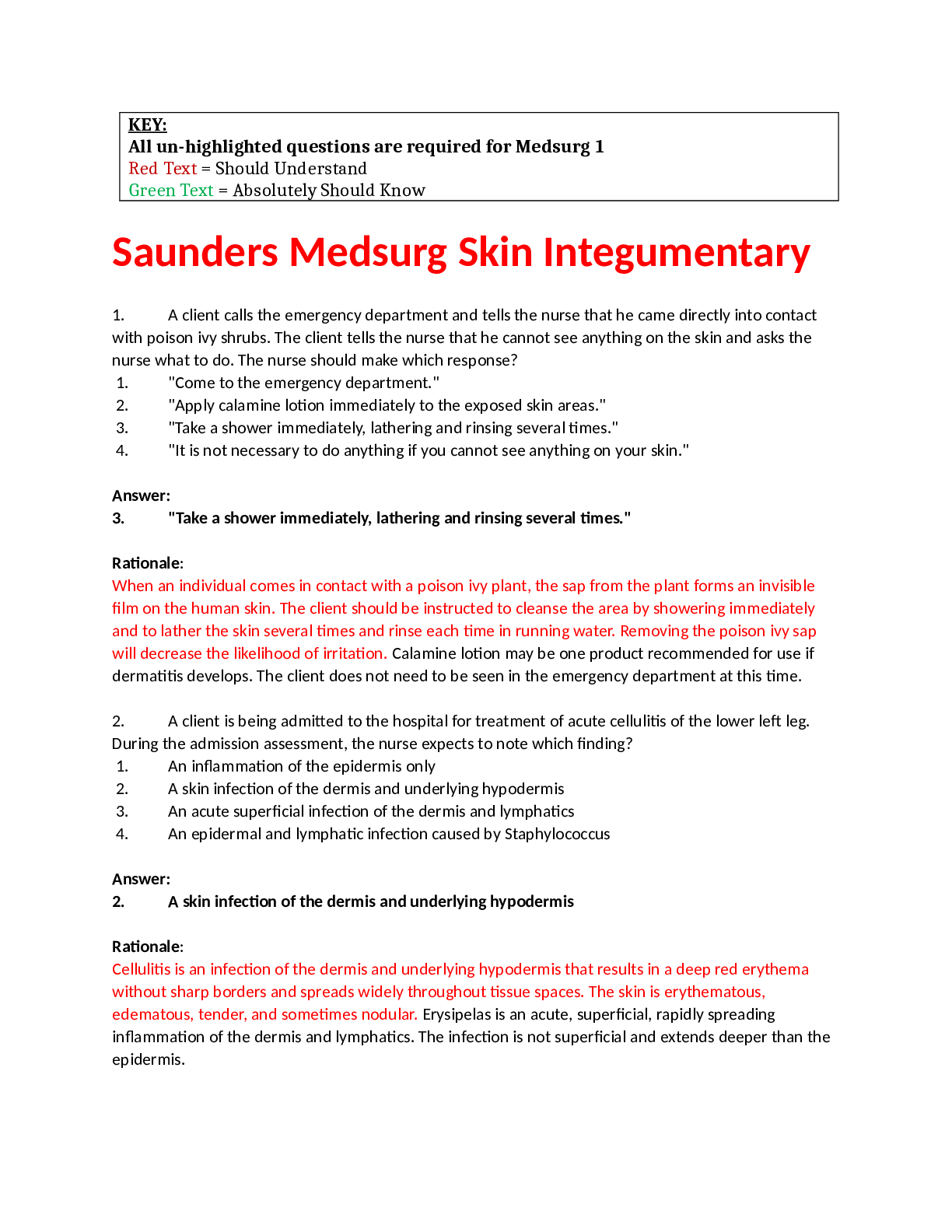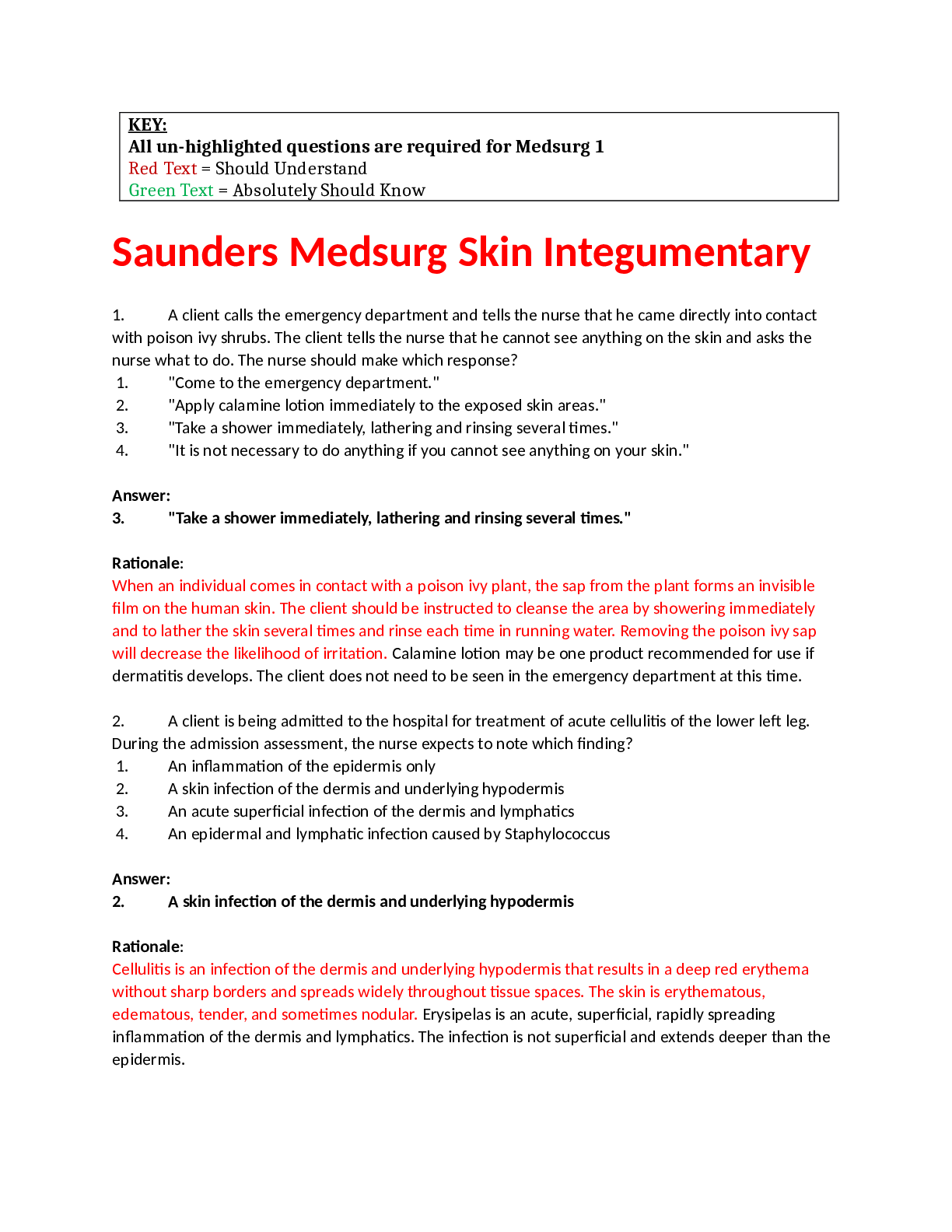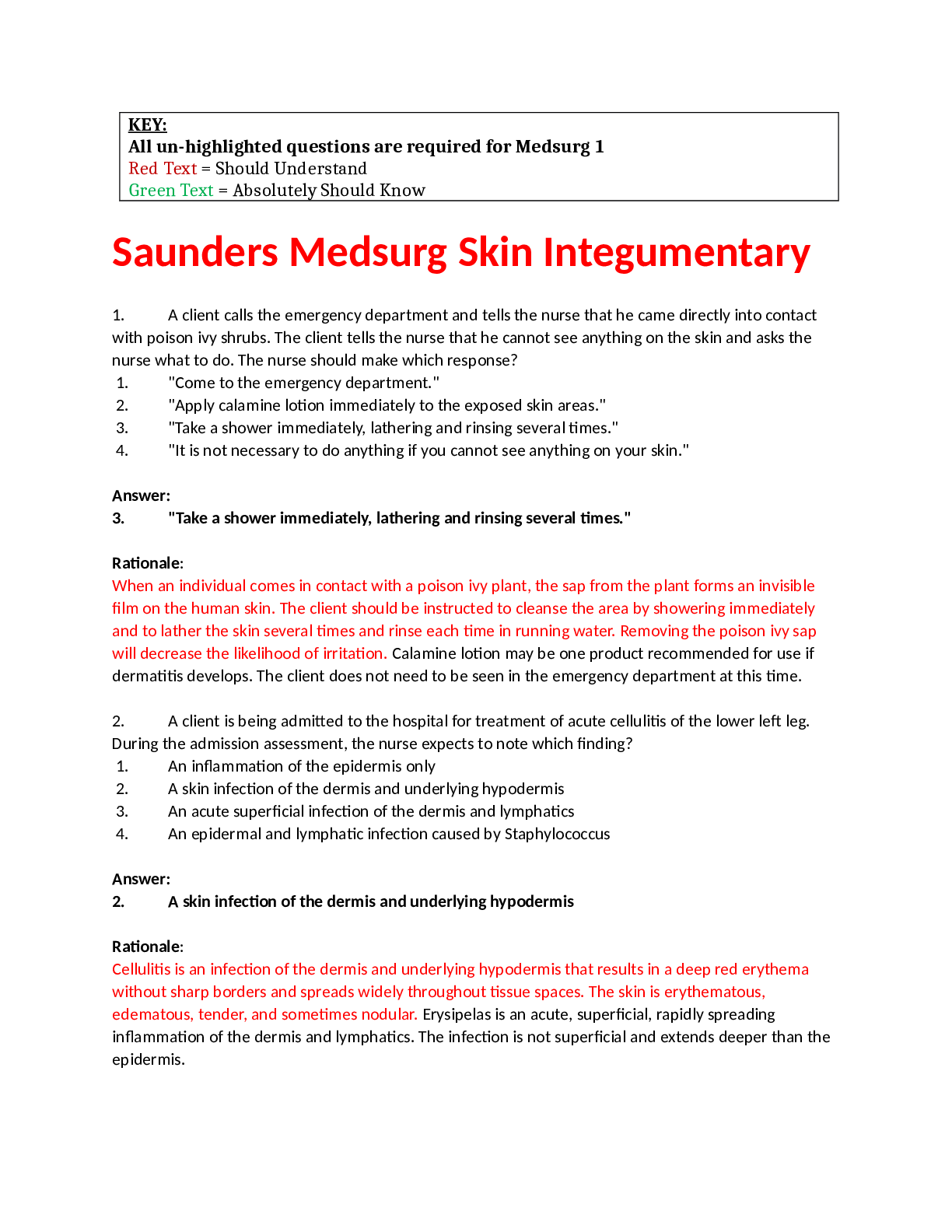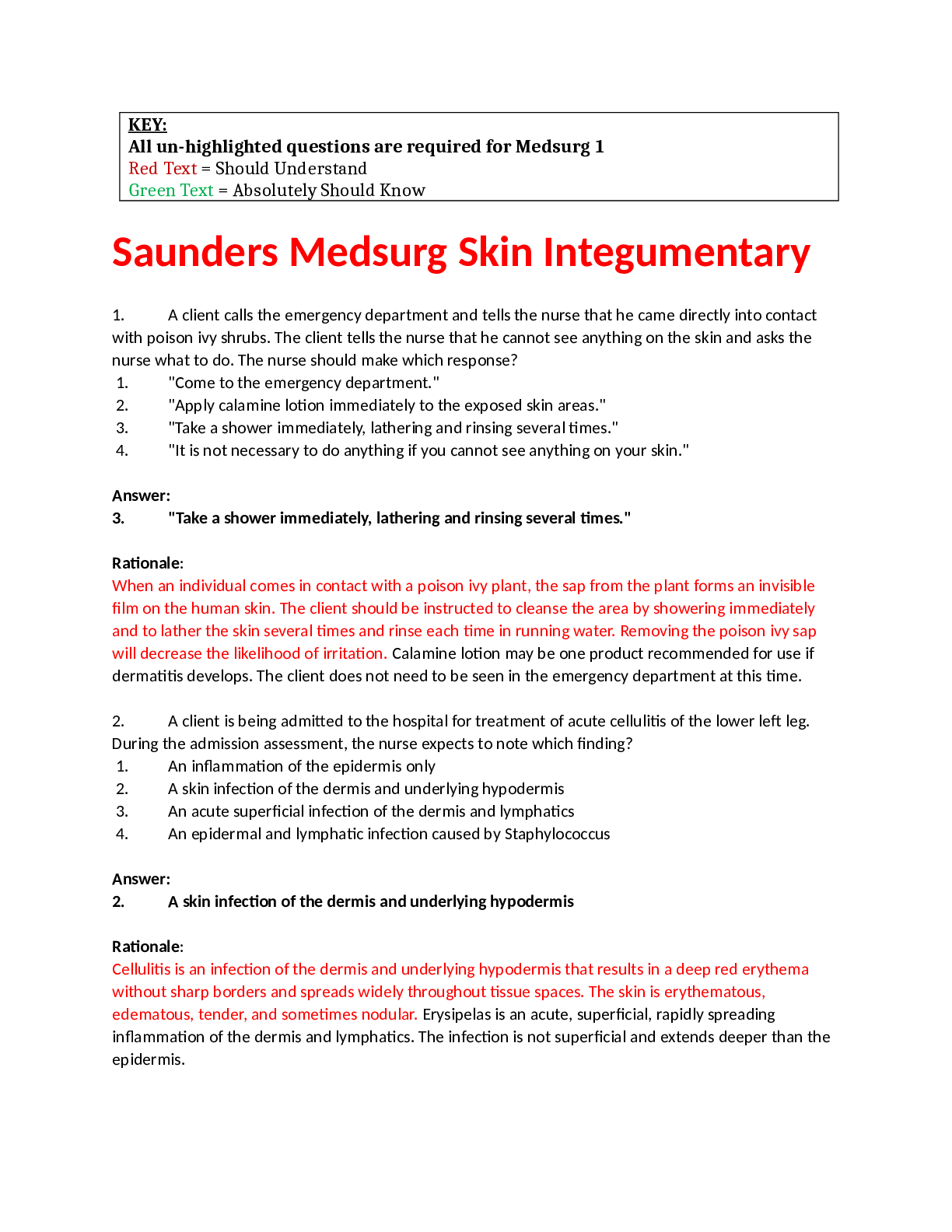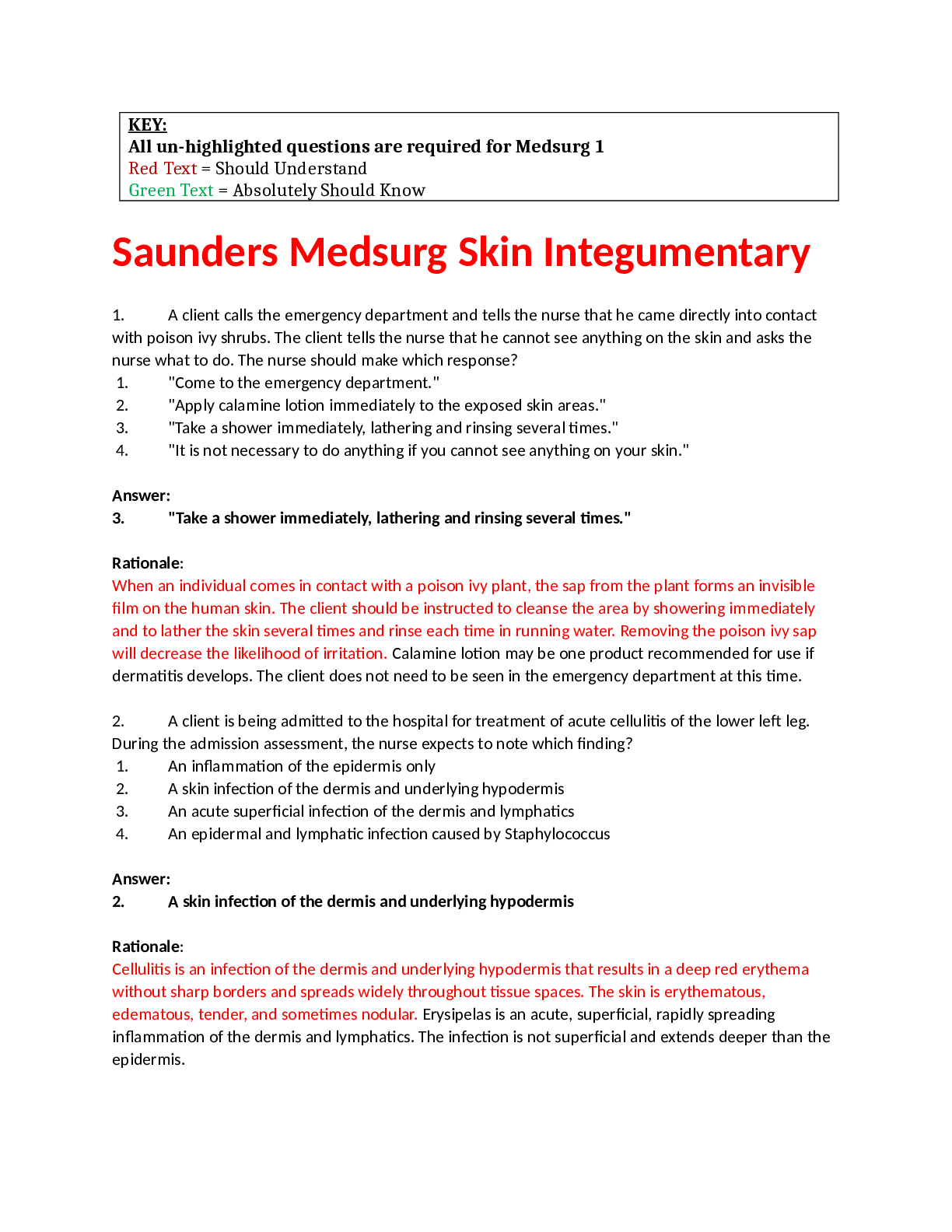*NURSING > EXAM > Saunders ATI Medsurg Skin Integumentary Revised | Saunders ATI Medsurg Skin Integumentary, A+ (All)
Saunders ATI Medsurg Skin Integumentary Revised | Saunders ATI Medsurg Skin Integumentary, A+
Document Content and Description Below
Saunders ATI Medsurg Skin Integumentary Revised | Saunders ATI Medsurg Skin Integumentary, A+-A client calls the emergency department and tells the nurse that he came directly into contact with poison... ivy shrubs. The client tells the nurse that he cannot see anything on the skin and asks the nurse what to do. The nurse should make which response? 1. "Come to the emergency department." 2. "Apply calamine lotion immediately to the exposed skin areas." 3. "Take a shower immediately, lathering and rinsing several times." 4. "It is not necessary to do anything if you cannot see anything on your skin." Answer: 3. "Take a shower immediately, lathering and rinsing several times." Rationale: When an individual comes in contact with a poison ivy plant, the sap from the plant forms an invisible film on the human skin. The client should be instructed to cleanse the area by showering immediately and to lather the skin several times and rinse each time in running water. Removing the poison ivy sap will decrease the likelihood of irritation. Calamine lotion may be one product recommended for use if dermatitis develops. The client does not need to be seen in the emergency department at this time. 2. A client is being admitted to the hospital for treatment of acute cellulitis of the lower left leg. During the admission assessment, the nurse expects to note which finding? 1. An inflammation of the epidermis only 2. A skin infection of the dermis and underlying hypodermis 3. An acute superficial infection of the dermis and lymphatics 4. An epidermal and lymphatic infection caused by Staphylococcus Answer: 2. A skin infection of the dermis and underlying hypodermis Rationale: Cellulitis is an infection of the dermis and underlying hypodermis that results in a deep red erythema without sharp borders and spreads widely throughout tissue spaces. The skin is erythematous, edematous, tender, and sometimes nodular. Erysipelas is an acute, superficial, rapidly spreading inflammation of the dermis and lymphatics. The infection is not superficial and extends deeper than the epidermis. 3. The clinic nurse assesses the skin of a client with psoriasis after the client has used a new topical treatment for 2 months. The nurse identifies which characteristics as improvement in the manifestations of psoriasis? Select all that apply. 1. Presence of striae 2. Palpable radial pulses 3. Absence of any ecchymosis on the extremities 4. Thinner and decrease in number of reddish papules 5. Scarce amount of silvery-white scaly patches on the arms Answers: 4. Thinner and decrease in number of reddish papules 5. Scarce amount of silvery-white scaly patches on the arms Rationale: Psoriasis skin lesions include thick reddened papules or plaques covered by silvery-white patches. A decrease in the severity of these skin lesions is noted as an improvement. The presence of striae (stretch marks), palpable pulses, or lack of ecchymosis is not related to psoriasis. 4. The clinic nurse notes that the health care provider has documented a diagnosis of herpes zoster (shingles) in the client's chart. Based on an understanding of the cause of this disorder, the nurse determines that this definitive diagnosis was made by which diagnostic test? 1. Positive patch test 2. Positive culture results 3. Abnormal biopsy results 4. Wood's light examination indicative of infection Answer: 2. Positive culture results Rationale: With the classic presentation of herpes zoster, the clinical examination is diagnostic. However, a viral culture of the lesion provides the definitive diagnosis. Herpes zoster (shingles) is caused by a reactivation of the varicella-zoster virus, the virus that causes chickenpox. A patch test is a skin test that involves the administration of an allergen to the surface of the skin to identify specific allergies. A biopsy would provide a cytological examination of tissue. In a Wood's light examination, the skin is viewed under ultraviolet light to identify superficial infections of the skin. 5. A client returns to the clinic for follow-up treatment following a skin biopsy of a suspicious lesion performed 1 week ago. The biopsy report indicates that the lesion is a melanoma. The nurse understands that melanoma has which characteristics? Select all that apply. 1. Lesion is painful to touch. 2. Lesion is highly metastatic. 3. Lesion is a nevus that has changes in color. 4. Skin under the lesion is reddened and warm to touch. 5. Lesion occurs in body area exposed to outdoor sunlight. Answers: 2. Lesion is highly metastatic. 3. Lesion is a nevus that has changes in color. Rationale: Melanomas are pigmented malignant lesions originating in the melanin-producing cells of the epidermis. Melanomas cause changes in a nevus (mole), including color and borders. This skin cancer is highly metastatic, and a person's survival depends on early diagnosis and treatment. Melanomas are not painful or accompanied by sign of inflammation. Although sun exposure increases the risk of melanoma, lesions are most commonly found on the upper back and legs and on the soles and palms of persons with dark skin. 7. A client arriving at the emergency department has experienced frostbite to the right hand. Which finding would the nurse note on assessment of the client's hand? 1. A pink, edematous hand 2. Fiery red skin with edema in the nail beds 3. Black fingertips surrounded by an erythematous rash 4. A white color to the skin, which is insensitive to touch Answer: 4. A white color to the skin, which is insensitive to touch Rationale: Assessment findings in frostbite include a white or blue color; the skin will be hard, cold, and insensitive to touch. As thawing occurs, flushing of the skin, the development of blisters or blebs, or tissue edema appears. Options 1, 2, and 3 are incorrect. 8. The evening nurse reviews the nursing documentation in a client's chart and notes that the day nurse has documented that the client has a stage II pressure ulcer in the sacral area. Which finding would the nurse expect to note on assessment of the client's sacral area? 1. Intact skin 2. Full-thickness skin loss 3. Exposed bone, tendon, or muscle 4. Partial-thickness skin loss of the dermis Answer: 4. Partial-thickness skin loss of the dermis Rationale: In a stage II pressure ulcer, the skin is not intact. Partial-thickness skin loss of the dermis has occurred. It presents as a shallow open ulcer with a red-pink wound bed, without slough. It may also present as an [Show More]
Last updated: 1 year ago
Preview 1 out of 36 pages
Instant download
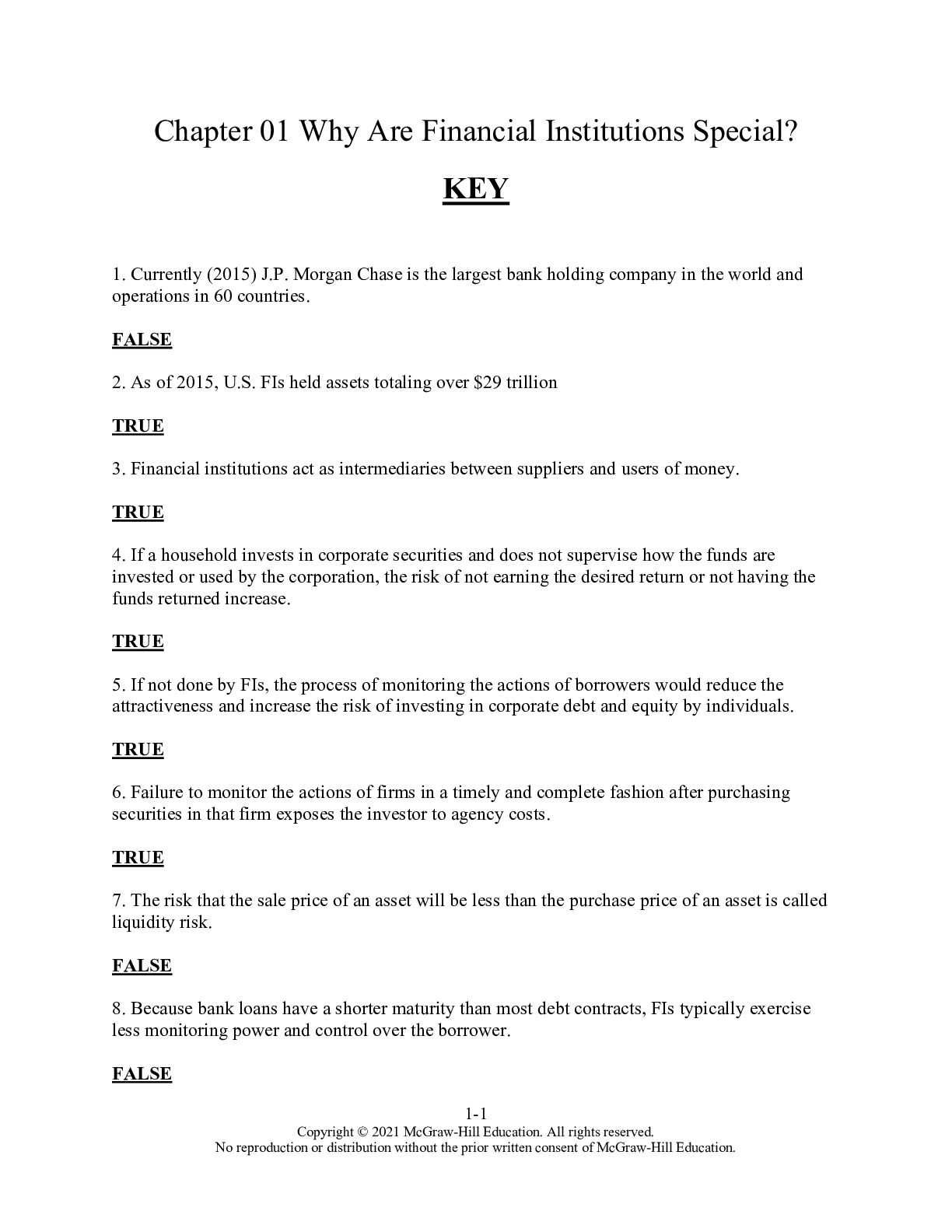
Buy this document to get the full access instantly
Instant Download Access after purchase
Add to cartInstant download
Reviews( 0 )
Document information
Connected school, study & course
About the document
Uploaded On
Jul 22, 2021
Number of pages
36
Written in
Additional information
This document has been written for:
Uploaded
Jul 22, 2021
Downloads
0
Views
41






